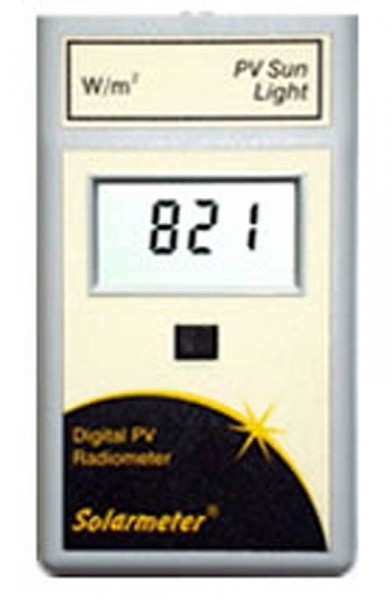- 01279 430831
- Contact us
- My Account
- Description
-
Details
Solarmeter Specifications
Radiometer Model 10.0 Irrad. Range 0-1999 W/m² Peak Response 940 nm Bandwidth 400-1100 nm Resolution 1 W/m² Accuracy ± 5% Ref. WRR Detector Silicon Photodiode Conv. Rate 3.0 Readings/Sec Display 3.5 Digit LCD Digit Size 0.4 inch high Oper. Temp 32° F TO100° F Oper. Humid. 5% TO 80% RH Dimensions (in.) 4.2L x 2.4W x 0.9D (inches) Weight 4.5 OZ. (incl. batt.) Power Source 9-Volt DC Battery Lens UV Glass Diffuser Virgin Teflon .005
Sensor/Detector
Silicon Photodiode packaged in hermetically sealed glass window cap.
Operation
Press and hold push-button switch on face of unit. Aim sensor window cap in top panel of meter directly at sun or perpendicular to panel array. Note reading on LCD and record value.
Battery operation voltage is 9V down to 6.5V. Below 6.5V the LCD numbers will begin to dim, indicating the need for battery replacement. Under "typical" service load, the battery should last about 2 years.
Proper Usage of Solarmeter ® Ultraviolet Radiometer for Lamp Tests:
Wear tinted eyewear or sunglasses when checking intense sunlight. Aim sensor directly at sun to see maximum solar irradiance as a reference. Aim sensor in same direction as PV panel to see irradiance striking array. Re-orient PV panel direction if desired for best average position. Maximum solar noon direction will of course vary throughout the year. Do not subject the meter to extremes in temperature, humidity, shock or dust. Use a dry, soft cloth to clean the intrument. Keep sensor free of oil, dirt, etc.
Proper Estimation of PV Panel Power:
Before beginning determine the following information from the mfgr of the module array:
Effective active area for the PV cells in square meters _________________ m² PV cells efficiency as percentage of input to output power ______________ % DC to AC conversion efficiency of the PV cell modules in the array _______ % Also, record the temperature near the back of the array _____________________ °C
It is best to do this when sun is directly shining on module near noon. The meter error will increase (read low) at angles greater than about 35° from direct at-sun conditions.
Example Calculation with PV Meter reading 1000 W/m² perpendicular to 10 m² array at 10 m² active area, 14% cells efficiency, 95% converter efficiency, 40° C:
1000 W/m² x 10 m² = 10000 Watts incoming sun power 10000 W x 0.14 cell efficiency = 1400 Watts 1400 W x 0.95 conversion efficiency = 1330 Watts Typical temperature coefficient loss for PV cells is -0.5% per degree C over 25°...
or 7.5% for 40° in this example (15° x 0.5% = 7.5% loss or 92.5% of above value. So:
1330 W x 0.925 = 1230 Watts. Lastly, a small wiring & component loss of ~1% reduces PV output down to ~1218 W.
Energy Production over Time:
The above 1218 Watts value is an "instantaneous" number. Energy is Watt (or kiloWatt) hours. So if the solar irradiance remained constant for an hour near noon, the energy produced would be 1218 WH.
To estimate power over the entire day... take readings every hour and apply the above examples. Then add up each hour's value x number of hours for daily WattHours. Of course the value will increase toward summer, peaking near June 21 in northern hemisphere... and decrease toward winter, lowest near December 21 solstice. Southern hemisphere is opposite.
Meter Calibration:
This instrument has been calibrated traceable to the World Radiometric Reference and is compliant with ANSI/NCSL Z540-1-1994. Model 10.0 Solarmeters are calibrated by transfer of "at sun" reading from master meter serial #00001. The master meter was calibrated to match standard class II pyranometer on a plane tilted 37° from horizontal, oriented perpendicular to the axis of the sun, under airmass 2 global solar irradiance at an independent test lab.
Master meter calibration certificate available on request.






